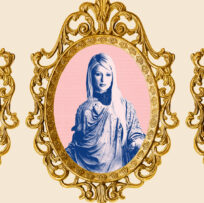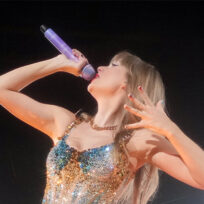What Would Ruth Bader Ginsburg Do? It’s a question I’ve asked myself multiple times between her death on September 18 and the November election. Sometimes the answer’s easy: She’d give a hell no to ramming through a Supreme Court appointee, and she’d argue for voting rights, and she’d tell you that abortion restrictions threaten a woman’s autonomy—these positions we know, because she wrote them down for us. She pointed the way with her immortal words and fierce, unflinching convictions.
But now I’m asking myself: WWRBGD about an enormous portrait of her made from 20,000 hand-painted tampons, boldly dominating the lobby of a new hotel in Washington, DC? (God, if one more person asks me that today…) It’s not a hypothetical, because Hotel Zena DC, which opened its doors in October, features just that. When I heard about it, I wasn’t sure how to feel: Is this a witty and winky act of homage? A weird and squicky form of commodified feminism? A groundbreaking but objectively neutral example of large-scale tampon pointillism (tampointillism)??

To answer that, you need to understand more about the hotel—and where it sits in a hospitality ecosystem of feminism as a selling point. Hotel Zena bills itself as “celebrating women’s accomplishments through over 60 pieces of provocative and immersive art—changing the conversation in Washington DC and throughout,” per the press release I couldn’t stop rereading. The art “revolves around the courage of some of the world’s most notable individuals and their fight for inclusivity and change.” I was promised a tampon RBG. I was promised a 20-foot-long installation made from 12,000 protest buttons. I was promised a spot called Hedy’s Rooftop, named after the esteemed inventor and star of The Birds. You bet I got my ass in an Uber for a tour.
And my hackles were up. As a travel journalist, I’ve noticed the trend of pay-to-stay places leveraging rah-rah Girl Power to drum up business. Take the Grand Hotel in Oslo, Norway, with its so-called Ladies Floor—all the rooms on it are named after famous Norwegian women. Or we all know about the Wing (and Luminary and the Coven and the Riveter, et al): female-focused coworking spaces with beautiful lighting and feminist (?) decor choices, such as a highly Instagrammable conference room named after Christine Blasey Ford. (Full disclosure, I’ve spent an inordinate amount of time thinking about this because my latest thriller, The Herd, is set in a fictional bougie all-female coworking space that looks hyper-feminist on the surface but suffers from, uh, the exact same inclusivity problems as the Wing.)

I could go on. Dukes Hotel in London offers Duchess rooms stocked with petite slippers, a fruit bowl, and a better-positioned hairdryer. In Hong Kong, Mira Moon introduced a ladies-only floor with hair straighteners, facial steamers, and an in-room tablet loaded with yoga and Pilates apps, and the Bella Sky Comwell in Copenhagen debuted women-only suites with international women’s magazines and a minibar stocked with smoothies, chocolate, and champagne. (The suites were later ruled “unlawful” after two men sued the property for discrimination, which is why we can’t have nice things.)
And, not to side with the litigious angry dudes, but I’m already not sure how I feel about “ladies-only floors.” On the one hand, the separation smacks of pinkwashing, like that idiotic Bics For Her pen: “OooOOoh, thank you, male-dominated industry, for providing tiny slippers and green juices appropriate for my inferior female body! #ladiesbeblowdrying!” Re: Hotel Zena, Arwa Mahdawi writes in The Guardian, “The whole thing feels like it was conjured up by Ivanka Trump in a fever dream,” which I’m not sure is true because the lobby is beautiful and Ivanka has no taste. But then… I like champagne, and I dislike too-big slippers. If you’re gonna name a suite after somebody, by all means, let’s go female. Hey, the vast majority of modern society was designed with dudes in mind—maybe it’s not a good use of righteous feminist anger to decry stuff created for women.
Was this brand-new hotel a true tribute to our gender or the guesthouse equivalent of a Women Who Rock issue, siloing women with their own little-league-y hurrah? Only one way to find out. I headed to Hotel Zena DC in late October, and the sprawling lobby lounge really does feel like an art gallery: white-walled and labyrinthine, with paintings, murals, and sculptures lurking in every nook and cranny. The press release promised more than 60 “large-scale and immersive” works of art focused on “female empowerment,” and I noticed all the wall art in the restaurant near the entrance was portraits of important women—some instantly recognizable, some I had to look up.
Next was the unmissable RBG portrait, with NOTORIOUS weaved into the side and large spikes instead of tampons where her collar would be. (According to the marketing head who showed me around, one male patron had remarked, “I didn’t know tampons came in so many colors!”, a sentiment I’ll be laughing about for weeks.) It’s impressive in person, hard to take in without stepping way back. I asked if the artist was female, and the answer was yes, more or less: Andrea Sheehan, the interior designer who plotted out the entire hotel, had the idea and designed the portrait herself, and Julie Coyle Art Associates (a female-owned studio that does employ men and women) produced it using tampons from CORA tampons, a company that’s donated millions of menstrual products stateside and abroad. (So they didn’t hire a capital-f Famous Female Tampon Artist to do the work, but women were still behind it.)

Sheehan explains, “I knew she needed to be honored in a way that spoke to the essence of what it is to be female. I had found a piece of art made of lipstick cartridges as pegs on a peg board, when it just hit me. Tampons. The thing women have been taught to be secretive about, embarrassed about—menstruation. The female curse. Justice Ginsburg and those like her have been fighting the female stigma forever. What could be a better tribute to her power and contribution?”
There was a massive painting of an apple—the forbidden fruit—by a California-based female artist; a mural of Diana the Huntress via a Baltimore-based, female-run studio; a ceramic sculpture that looks simultaneously like a cocoon and a woman’s hips; a huge round birth-control pill case painted on the wall in the bathroom, bewilderingly turned into the male symbol. There are breathtaking portraits of Shirley Chisholm and Gloria Steinem and Wai Wai Nu and Rosa Parks. There’s a Wall of Honor covered in 221 charcoal portraits of important women from history—Sojourner Truth and Malala Yousafzai sharing space with Barbara Bush and Cleopatra—carried out by a group of female artists in the San Francisco Bay. Outside, there’s a mural of two female, non-white “warrior guardians” by local artist Miss Chelove. It’s all very cool and Instagram-worthy.

But it is, yup, a corporate entity (Zena is owned by Viceroy Hotels and Resorts) making money off the likenesses of powerful women. Some of whom are very much alive, in fact. Countless pieces of art have portrayed Gloria Steinem and HRC and Malala, no doubt, but how many of those make up the marketing material for a boutique hotel? No way the creators consulted with Malala before commissioning her charcoal portrait (although I do enjoy the thought of her getting an email from Viceroy and being like, “….I’m sorry, what?” in her magnificently poised way). I’m not calling any of it wrong, but soaking it in, I couldn’t help but vacillate between awe and ick.
I noticed the marketing manager kept mentioning “female empowerment” when she seemed to mean “feminism” and asked if their branding includes not using the F-word.
“That’s right, because we want it to be inclusive, not divisive,” she replied, which made my eyes roll right out of my head. Like, we can pretend feminism is a ~cONtrOversiAl tERm~, or we can all agree that the political, economic, and social equality of the sexes is a pretty basic starting point. (And c’mon, the assholes screaming, “Keep America Great,” internal logic be damned, are not about to book a junior suite in this particular property.) To me, this kind of language-policing kowtows to the “I’m not a feminist, but…” crowd, demonizing what’s not at all a radical word. But then I asked the PR team to clarify, and they told me, “We do use the word feminist to describe the artists (both male and female) who contributed to the hotel and the feminist movement that is depicted in many of the art pieces.” So, IDK. I guess if you’re in DC and want to appeal to the 74 million Americans who just sided with the pussy-grabber-in-chief, you choose your words carefully.
Speaking of feminist artists: About 80 percent of the artwork is by women, and 70 percent of the art focuses on women of color. Eight of eleven leadership positions at the hotel are held by women, and the lobby restaurant and lounge, Figleaf, sources ingredients from female-owned distilleries and farmers, and serves cocktails with names like HBIC, Empowermint, and The Earhart. (The head chef, however, is male.) A portion of each room rate goes to N Street Village, a non-profit empowering homeless and low-income women in Washington, D.C., and Rush Limbaugh detested the RBG portrait, which leaves me inclined to love it.
Basically, I see why some are cringing at the concept, but I dig what Hotel Zena’s trying to do—they seem to be living their values, and they’ve created a cool community space (anyone can hang out in the lobby) celebrating women. The hotel’s marketing person mentioned that the female interior designer has been drawing up hotel plans for decades, and the spaces are so often masculine: dark wood and heavy drapes and smooth metal, the penis-y take on ~luxury~. As a travel writer specializing in high-end hotels, I can back this up—even art-focused hotels tend to be dark and dramatic, and traditional hotels will unthinkingly cover a wall in portraits of, say, famous composers throughout the centuries (#somanywhiteguys). It’s thrilling to walk through a building with activists and goddesses and dancing female druids studding the walls. And—internalized misogyny alert—it should not feel so weird to see so much art glorifying women.

But WWRBGD? On the tour, the marketing manager mentioned they’d hoped to have an unveiling with her, but she passed away just a couple weeks before their doors opened. They trusted that the judge, known for her wicked sense of humor, would have liked it—or at least found it funny. Let the record show: She got a kick out of the Notorious RBG branding as well as, “You can’t have the truth without Ruth” T-shirts. (Would you find it funny if someone made a portrait of you out of 20,000 tampons? I would.)
So we’ll never know. I pressed the PR team for details on RBG’s reception (literal and emotional), and they couldn’t give an update. “It is with the utmost respect that we created this intimate tribute to an amazing woman,” came the reply. “This portrait honors both Justice Ginsburg’s life-long dedication to women’s rights as well as her humor, and does so in the most personal and intimate form.”
When I hung out in Hotel Zena’s lounge, I watched some children—a boy and a girl—zoom around the lobby, taking in all the artwork. Pinkwashing is a scourge, yes, but if those kids start to think it’s normal for public spaces to glorify women, well. Who am I to get all worked up (especially when there are very real political battles ahead)? In the words of Ruth Bader Ginsburg herself, “Don’t be distracted by emotions like anger, envy, resentment. These just zap energy and waste time.” Let’s drink our smoothies and take the win, and then refocus on the work begun by the awesome women immortalized in a hotel lobby.
Images: Mike Schwartz Photography




















































